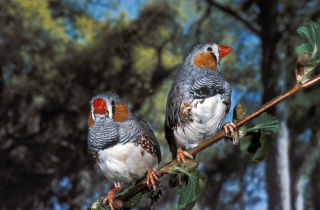Researchers from McGill University and the University of California, San Francisco have developed a new algorithm capable of identifying features of male zebra finch songs that may underlie the distinction between a short phrase sung during courtship, and the same phrase sung in a non-courtship context.
In a recent study published in PLOS Computational Biology, the team looked at how male zebra finches adapted their vocal signals for specific audiences. Though they may sing the same sequence of syllables during courtship interactions with females as when singing alone, they will do so with subtle modifications. However, humans cannot detect these differences, and it was not clear that female zebra finches could, either.
The researchers first conducted behavioral experiments demonstrating that female zebra finches are indeed highly adept at discriminating between short segments of males' songs recorded in courtship versus non-courtship settings.
Not the same old song
Subsequently, they sought to expand on earlier studies that have focused on just a few specific song features that may underlie the distinction between courtship and non-courtship song. Taking a 'bottom-up' approach, the researchers extracted over 5,000 song features from recordings and trained an algorithm to use those features to distinguish between courtship and non-courtship song phrases.
"As vocal communicators ourselves, we have a tendency to focus on aspects of communication signals that are salient to us," explains Sarah Woolley, Associate Professor in the Department of Biology at McGill and one of the co-authors of this study. "Using our bottom-up approach, we identified features that might never have been on our radar."
The trained algorithm uncovered features that may be key for song perception, some of which had not been identified previously. It also made predictions about the distinction capabilities of female zebra finches that aligned well with the results of the behavioral experiments. These findings highlight the potential for bottom-up approaches to reveal acoustic features important for communication and social discrimination.
In terms of next steps, the researchers plan to test whether manipulating the acoustic features they discovered alters what female finches think about those songs. They also hope to evaluate how well their findings might generalize to courtship and non-courtship songs in other species.
| About this study "Behavioral discrimination and time-series phenotyping of birdsong performance" by Sarah C. Woolley, Jon Sakata and al. was published in PLOS Computational Biology. This study was funded by National Science and Engineering Council of Canada, the Fonds de recherche Nature et Technologies and the Canadian Foundation for Innovation Canadian Foundation for Innovation, |
About McGill University
Founded in Montreal, Quebec, in 1821, McGill University is Canada's top ranked medical doctoral university. McGill is consistently ranked as one of the top universities, both nationally and internationally. It is a world-renowned institution of higher learning with research activities spanning two campuses, 11 faculties, 13 professional schools, 300 programs of study and over 40,000 students, including more than 10,200 graduate students. McGill attracts students from over 150 countries around the world, its 12,800 international students making up 31% of the student body. Over half of McGill students claim a first language other than English, including approximately 19% of our students who say French is their mother tongue.







